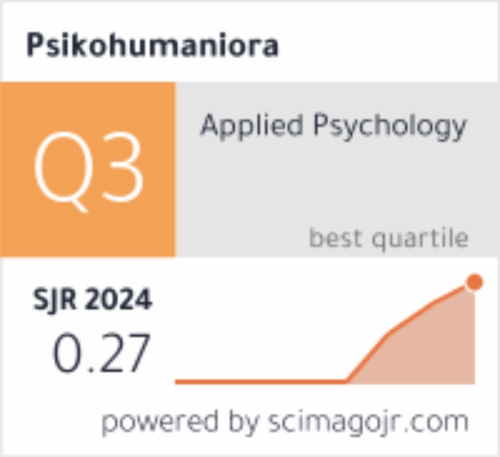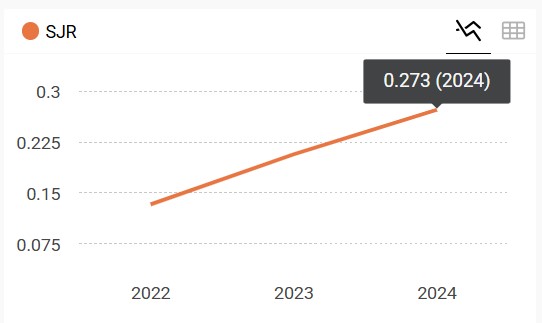Peningkatan Resiliensi Perempuan Korban Pelecehan Seksual Melalui Pelatihan Regulasi Emosi
DOI:
https://doi.org/10.21580/pjpp.v3i1.2527Keywords:
emotional regulation training, resilience, sexual harassmentAbstract
Abstract: This research aims to determine the effectiveness of emotional regulation training in increasing resilience in women victims of sexual harassment. Participants in this study were four female victims of sexual harassment. Participants age are 18-30 years and had a moderate to low level resilience score. The research design was one group pre-test post-test. Data collected using resilience scale with Likert model based on resilience aspect from Kumpfer (1999) prepared by the researcher. Emotion regulation training modules were prepared by researcher based on Greenberg theory (2002). Wilcoxon Signed Rank Test technique is used by researcher to test for differences of pre-test, post-test, and post-test2 (follow up) data score. Results of pre-test - post-test analysis showed p value of 0.034 and post-test2 (follow up) with p value of 0.033 (p <0.05). From the result can be concluded that emotional regulation training is effective in increasing resilience in women victims of sexual harassment.
Abstrak: Penelitian ini berujuan untuk mengetahui pengaruh pelatihan regulasi emosi terhadap peningkatan resiliensi pada perempuan korban pelecehan seksual. Partisipan pada penelitian ini merupakan empat perempuan korban pelecehan seksual. Usia partisipan adalah 18-30 tahun dan memiliki skor tingkat resiliensi sedang sampai dengan sedang. Desain penelitian yang digunakan adalah one group pre-test post-test. Pengumpulan data penelitian dilakukan dengan menggunakan skala resiliensi model Likert yang disusun oleh peneliti berdasarkan aspek resiliensi dari Kumpfer (1999). Modul pelatihan regulasi emosi disusun berdasarkan teori Greenberg (2002). Teknik analisis Wilcoxon Signed Rank Test digunakan peneliti untuk menguji perbedaan skor data pre-test, post-test, dan post-test2 (follow up). Hasil analisis pre-test – post-test menunjukkan nilai p sebesar 0.034 dan post-test2 (follow up) dengan nilai p sebesar 0.033 (p<0.05). Hasil penelitian menunjukkan bahwa pelatihan regulasi emosi efektif untuk meningkatkan resiliensi pada perempuan korban pelecehan seksual.Downloads
References
Adheswary, V. (2010). Sexual abuse women in the work as secretary. Depok: Universitas Gunadharma.
Andriani, V. (2005). Hubungan minat profesi pendeta dan konsep diri dengan prestasi akademik mahasiswa Sekolah Tinggi Theologia HKBP Pematang Siantar. Universitas Gadjah Mada Yogyakarta.
Azwar, S. (2013). Penyusunan skala psikologi. Yogyakarta: Pustaka Pelajar.
Azzahra, F. (2017). Pengaruh resiliensi terhadap distres psikologis pada mahasiswa. Jurnal Ilmiah Psikologi Terapan, 05(01), 80–96.
Bukhori, B. (2006). Kesehatan mental mahasiswa ditinjau dari religiusitas dan kebermaknaan hidup. Psikologika: Jurnal Pemikiran dan Penelitian Psikologi, 11(22), 93–106. Retrieved from http://journal.uii.ac.id/Psikologika/article/view/272/7385
Bukhori, B., Hassan, Z., Hadjar, I., & Hidayah, R. (2017). The effect of sprituality and social support from the family toward final semester university students’ resilience. Man in India, 97(19), 313–321.
Charney, D. S. (2004). Psychobiological mechanisms of resilience and vulnerability: Implications for successful adaptations to extreme stress. The American Journal of Psychiatry, 161(2), 195–216. https://doi.org/10.1176/foc.2.3.368
Cloninger, C. R., & Zohar, A. H. (2011). Personality and the perception of health and happiness. Journal of Affective Disorders, 128(1–2), 24–32. https://doi.org/10.1016/ j.jad.2010.06.012
Collier, R. (1998). Pelecehan seksual: Hubungan dominasi mayoritas dan minoritas. Yogyakarta: Tiara Wacana Yogya.
Desmita. (2012). Psikologi perkembangan. Bandung: Remaja Rosdakarya.
Dyrbye, L., & Shanafelt, T. (2012). Nurturing resiliency in medical trainees. Medical Education, 46(4), 343. https://doi.org/10.1111/j.1365-2923.2011.04206.x
Everall, R. D., Altrows, K. J., & Paulson, B. L. (2011). Creating a future: A study of resilience in suicidal female adolescents. Journal of Counseling & Development, 84(4), 461–470. https://doi.org/10.1002/j.1556-6678.2006.tb00430.x
Garmezy, N. (1993). Children in poverty: Resilience despite risk. Journal Psychiatry: Interpersonal and Biological Processes, 56(1), 127–136. https://doi.org/10.1080/ 00332747.1993.11024627
Gohm, C. L. (2003). Mood regulation and emotional intelligence: Individual differences. Journal of Personality and Social Psychology, 84(3), 594–607.
Gottman, J., & DeClaire, J. (1997). The Heart of Parenting: Raising an Emotionally Intelligent Child. (D. Goleman, Ed.). London: Bloomsbury.
Greenberg, J. S. (2002). Comprehensive stress management. USA: McGraw-Hill Book Company Inc.
Greenberg, M., & Stone, A. A. (1992). Emotional Disclosure About Traumas and Its Relation to Health: Effects of Previous Disclosure and Trauma Severity. Journal of Personality and Social Psychology, 63(1), 75–84. https://doi.org/10.1037%2F0022-3514.63.1.75
Gross, J. J., & John, O. P. (2003). Individual differences in two emotion regulation processes: implications for affect, relationships, and well-being. Journal of Personality and Social Psychology, 85(2), 348–362.
Grotberg, E. H. (1995). A guide to promoting resiliency in children: Strengthening the human spirit. Early Chidhood Development: Practice and Reflections (Vol. 8). Netherlands: Bernard van Leer Foundation.
Grotberg, E. H. (1999). Countering Depression with the five building blocks of resilience. Reaching Today’s Youth, 4(1), 66–72. Retrieved from http://search.ebscohost. com/login.aspx?direct=true&db=eric&AN=EJ612641&site=ehost-live%5Cnhttp://search.ebscohost.com/login.aspx?direct=true&db=eric&AN=EJ612641&site=ehost-live&scope=site
Hurlock, E. B. (2002). Psikologi perkembangan: Suatu pendekatan sepanjang rentang kehidupan. (R. M. Sijabat, Ed.) (5th ed.). Jakarta: Erlangga.
I., I. (2017). wawancara 27 Januari 2017.
Irwanto. (2004). Gambaran anak yang mengalami kekerasan seksual. Jakarta: Unika Atmajaya.
Kendall-Tackett, K. A., Williams, L. M., & Finkelhor, D. (1993). Impact of sexual abuse on children: a review and synthesis of recent empirical studies. Psychological Bulletin, 113(1), 164–180.
Komisi Nasional Anti Kekerasan terhadap Perempuan. (2012). Stagnansi sistem hukum: Menggantung asa perempuan korban - Catatan tahunan tentang kekerasan terhadap perempuan tahun 2011. Jakarta. Retrieved from https://www.komnasperempuan. go.id/reads-catatan-tahunan-tentang-kekerasan-terhadap-perempuan-2012
Komisi Nasional Anti Kekerasan terhadap Perempuan. (2011). Teror dan kekerasan terhadap perempuan: Hilangnya kendali negara - Catatan kekerasan terhadap perempuan tahun 2010. Jakarta. Retrieved from https://www.komnasperempuan.go.id/reads-catatan-tahunan-tentang-kekerasan-terhadap-perempuan-2011
Komisi Nasional Anti Kekerasan terhadap Perempuan. (2013). Korban berjuang, publik bertindak: Mendobrak stagnansi sistem hukum - Catatan kekerasan terhadap perempuan tahun 2012. Retrieved January 15, 2018, from https://www.komnasperempuan.go.id/reads-catatan-tahunan-tentang-kekerasan-terhadap-perempuan-2013
Komisi Nasional Anti Kekerasan terhadap Perempuan. (2014). Kegentingan Kekerasan Seksual: Lemahnya Upaya Penanganan Negara - Catatan Kekerasan terhadap Perempuan Tahun 2013. Jakarta. Retrieved from https://www.komnasperempuan.go.id/reads-catatan-tahunan-tentang-kekerasan-terhadap-perempuan-2014
Komisi Nasional Anti Kekerasan terhadap Perempuan. (2015). Kekerasan terhadap Perempuan: Negara Segera Putus Impunitas Pelaku - Catatan Tahunan tentang Kekerasan terhadap Perempuan Tahun 2014. Jakarta.
Komisi Nasional Anti Kekerasan terhadap Perempuan. (2016). Kekerasan terhadap perempuan meluas: negara urgen hadir hentikan kekerasan terhadap perempuan di ranah domestik, komunitas dan negara: Catatan kekerasan terhadap perempuan tahun 2015. Retrieved from https://www.komnasperempuan.go.id/reads-catatan-tahunan-tentang-kekerasan-terhadap-perempuan-2016
Komnas Perempuan. (2013). 15 Bentuk kekerasan seksual: sebuah pengantar. Jakarta: Komnas Perempuan.
Kumpfer, K. L. (1999). Factors and processes contributing to resilience: The resilience framework. In M. D. Glantz & J. L. Johnson (Eds.), Resilience and development: Positive life adaptations (pp. 179–224). New York: Kluwer Academic - Pienum Publishers. https://doi.org/10.1007/b108350
Kusumana, G. (2013). Pelecehan seksual di tempat kerja (Kondisi di Indonesia dan cara mengatasinya). Retrieved from www.nakertrans.go.id
L., L. (2017). wawancara 24 Januari 2017.
Latipun. (2011). Psikologi Eksperimen. Malang: UMM Press.
Linehan, M. M., Schmidt, H., Dimeff, L. A., Craft, J. C., Kanter, J., & Comtois, K. A. (1999). Dialectical Behavior therapy for patients with borderline personality disorder and drug‐dependence. The American Journal of Addictions, 8(4), 279–292. https://doi.org/ 10.1080/105504999305686
Mustafa-EQ, Z. (2009). Mengurai Variabel Hingga Instrumentasi. Yogyakarta: Graha Ilmu.
Ni’mah, E., & Sulistyarini, I. (2012). Efektivitas pelatihan regulasi emosi untuk meningkatkan resiliensi pada ibu yang memiliki anak autis. Surabaya: Program Studi Psikologi Fakultas Dakwah IAIN Sunan Ampel.
Reivich, K., & Shatte, A. (2002). The Resilience Factor: 7 Essential Skills for Overcoming Life’s Inevitable Obstacles. New York: Broadway Books.
Richardson, G. E. (2002). The metatheory of resilience and resiliency. Journal of Clinical Psychology, 58(3), 307–321. https://doi.org/10.1002/jclp.10020
Rinaldi, R. (2010). Resiliensi pada masyarakat kota padang ditinjau dari jenis kelamin. Jurnal Psikologi, 3(2), 99–105.
Ross, C. E., & Mirowsky, J. (2001). Neighborhood disadvantage, disorder, and health. Journal of Health and Social Behavior, 42(3), 258. https://doi.org/10.2307/3090214
Safaria, T., & Saputra, N. (2012). Manajemen emosi : Sebuah panduan cerdas bagaimana mengelola emosi positif dalam hidup Anda. Jakarta: Bumi Aksara.
Schoon, I. (2006). Risk and resilience: Adaptations in changing times. London: Cambridge University Press. https://doi.org/Doi 10.1080/01443410701491874
Smyth, J. M. (1998). Written emotional expression: Effect sizes, outcome types, and moderating variables. Journal of Consulting and Clinical Psychology, 66(1), 174–184. https://doi.org/10.1037/0022-006X.66.1.174
Sugiyono. (2009). Metode penelitian bisnis (Pendekatan kuantitatif, kualitatif, dan R&D). Bandung: Alfabeta.
Suseno, M. (2012). Statistika: Teori dan aplikasi untuk penelitian ilmu sosial dan humaniora. Yogyakarta: Ash-Shaff.
Tempski, P., Martins, M. A., & Paro, H. B. M. S. (2012). Teaching and learning resilience: A new agenda in medical education. Medical Education, 46(4), 345–346. https://doi.org/ 10.1111/j.1365-2923.2011.04207.x
Tim Rifka Annisa. (2013). Dokumentasi data kasus Rifka Annisa WCC Yogyakarta (2013). Retrieved January 30, 2017, from http://perempuan.or.id/2010/12/14/stop-pelecehan-seksual-terhadap-perempuan/
Tugade, M. M., & Fredrickson, B. L. (2004). Resilient individuals use positive emotions to bounce back from negative emotional experiences. Journal of Personality and Social Psychology, 86(2), 320–333. https://doi.org/10.1037/0022-3514.86.2.320
Tugade, M. M., & Fredrickson, B. L. (2007). Regulation of positive emotions: Emotion regulation strategies that promote resilience. Journal of Happiness Studies, 8(3), 311–333. https://doi.org/10.1007/s10902-006-9015-4
Werner, E. E., & Smith, R. S. (1982). Vulnerable, but invincible : a longitudinal study of resilient children and youth (Norman Gar). New York: McGraw-Hill Book Company Inc.
X., X. (2017). wawancara 24 Januari 2017.
Zastrow, C., & Kirst-Ashman, K. K. (1989). Understanding human behavior and the social environment. Chicago: Nelson-Hall Publishers.
Downloads
Published
How to Cite
Issue
Section
License
The copyright of the accepted article shall be assigned to the publisher of the journal. The intended copyright includes the right to publish the article in various forms (including reprints). The journal maintains the publishing rights to published articles.
In line with the license, authors and any users (readers and other researchers) are allowed to share and adapt the material only for non-commercial purposes. In addition, the material must be given appropriate credit, provided with a link to the license, and indicated if changes were made. If authors remix, transform, or build upon the material, authors must distribute their contributions under the same license as the original.




